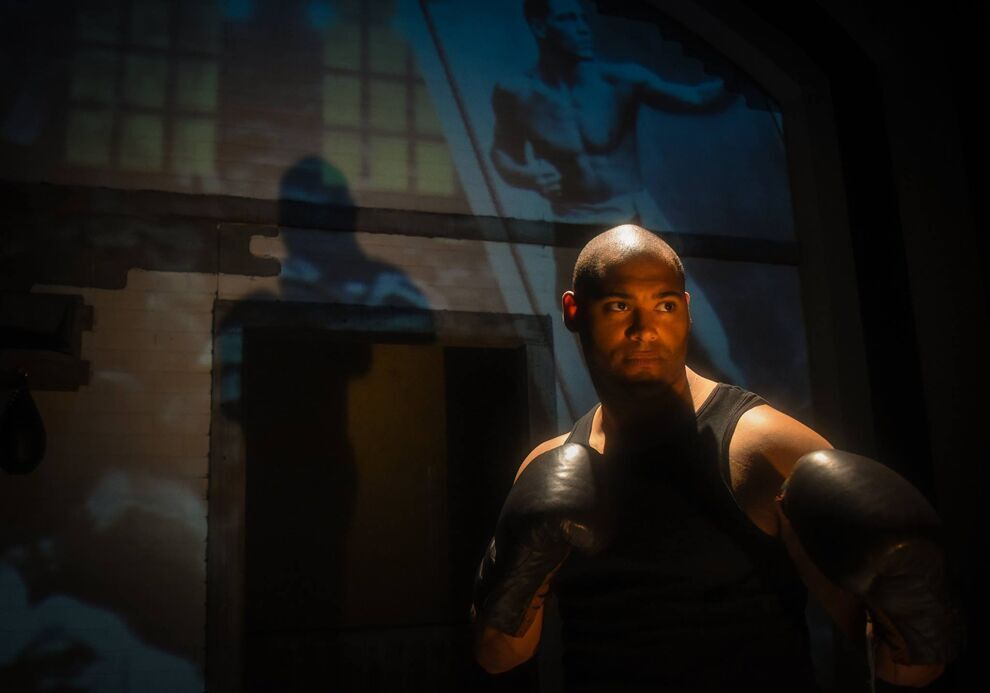Chasing Champions makes for potent theatre.

Chasing Champions: The Sam Langford Story
By Jacob Sampson
A Ship’s Company (Parrsboro, NS) production in association with Eastern Front Theatre (Halifax) at the NAC Azrieli Studio
Directed by Ron Jenkins
He’s blind and impoverished, a forgotten figure in a Harlem care home. Yet there’s something resilient about him. An element of ruefulness may underly his stoicism, yet there’s an almost jaunty suggestion that he remains one of the undefeated — in his own mind anyway.
We meet him in a wheelchair in a boxing ring — an appropriate place of the imagination for a retired boxer whose spiritual home, even in old age, remains the square of canvas on which he once fought his way into sports mythology and then into a wider obscurity. One of the many virtues of Chasing Champions, which has made a stunning arrival at the NAC’s Studio, is its success in plunging us immediately and persuasively into the last century and into the life and times of Sam Langford, the forgotten black Nova Scotian acclaimed by some ring historians as the greatest boxer who ever lived — and, by implication, the greatest champion who never was.
That opening scene is significant for a number of reasons. It is already making the case that playwright Jacob Sampson, who also takes on the role of his forgotten hero, is an accomplished dramatist, canny enough to seize our attention at once, and confident enough to pilot us seamlessly through a non-linear series of snapshots in which both present and past vie for our attention.
We are first seeing the aged, impoverished Sam through the eyes of the New York Herald-Tribune reporter who has tracked him down decades after his heyday in the ring. That’s when we initially detect the resilience and fortitude behind the dark glasses and physical infirmity. But suddenly the glasses are whipped off and Sam rises from his wheelchair to transport us to the turn of the last century and the moment the teenager he once was is confronted with the possibility of a fight career.
What’s striking is the fluidity with which this transition has been managed. There’s the quicksilver authority which which Sampson’s performance abandons the trappings of age and morphs into this street-smart kid who discovers that he has a way with his fists. There’s also fellow actor Marty Burt’s confident switchover from fawning journalist at the beginning to the character of the tough-minded fight manager who will end up playing a key role in Sam’s life.
There’s already a sense of everything working, of a collective theatrical purpose. The show has been directed by Edmonton’s Ron Jenkins, who gave NAC audiences a brilliant production of Lucy Prebble’s Enron a few seasons ago. Jenkins ensures that Sampson’s material is delivered with the dramatic urgency it needs. Furthermore, he elevates some boxing scenes into the mythic: consider the growing rhythmic intensity with which Sam cuts and jabs at his own shadow, with the entire NAC Studio becoming the vessel for a succession of whip-cracking moments. The result: a remarkable fusion of sight and sound.
Visually, this a production of breathtaking confidence — a testament to the combined vision of Jenkins, Garrett G. Barker (set design), Leigh Ann Vardy (lighting), Corwin Ferguson (videos and projections) and Joe Micallef (sound). It is also a powerful ensemble achievement with Jacob Sampson’s formidable centrepiece performance supported by the excellent work of Marty Burt, Micha Cromwell and Zach Faye in a variety of roles.
This not the first time that the world of boxing has taken over the stage. Clifford Odets’s Golden Boy comes to mind and, more recently, Howard Sackler’s The Great White Hope in which James Earl Jones delivered a lacerating performance as Jack Johnson, the first black heavyweight champion of the world. Both these works gave us severely conflicted heroes. With Chasing Champions, the conflict seems somewhat muted, which might seem dangerous dramatically but also be a testament to the playwright’s determination to create a work of integrity and truth without garnishing it with questionable melodramatic flourishes.
Meanwhile, the conflict does creep through. In Sam’s frustration over Jack Johnson’s refusal to grant him a title shot. In the reluctance of others to enter the ring with him and face those relentless fists. In the fissures that fame, and its consequences, create in his own marriage. And in the racist climate of the time — and yes, racism, sometimes subtle, sometimes overt, is here in all its perfidiousness
The Sam Langford emerging from Sampson’s performance is an engaging human being, but the inner turbulence is there. Sometimes it erupts, leading to a scalding confrontation with Sam’s wife, played by Micha Cromwell. Sometimes it’s kept under control — for example in an overseas meeting with a future opponent, who turns out to be a sneering racist while Sam, in a quietly powerful moment, manages to keep his cool.
Chasing Champions is a product of Ship’s Company Theatre, an enterprising organization based in Nova Scotia’s Cumberland County. The NAC English theatre, under artistic director Jillian Kelley, continues to pursue a rewarding mandate of showcasing the best of Canada’s regional theatres, both large and small. This show is a stellar vindication of that policy.
Chasing Champions: The Sam Langford Story continues at the NAC to November 24.
Director: Ron Jenkins
Set: Garrett G. Barker
Lighting: Leigh Ann Vardy
Sound: Joe Micallef
Video and projection design: Corwin Ferguson
Costumes: Cathleen McCormack
Cast:
Marty Burt
Micha Cromwell
Zach Faye
Jacob Sampson